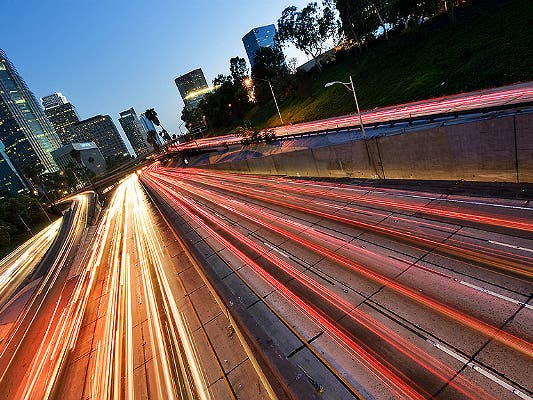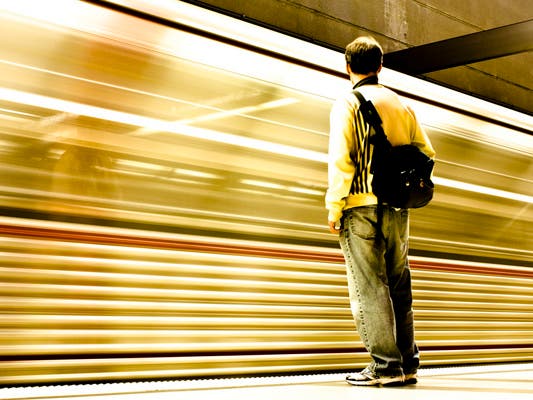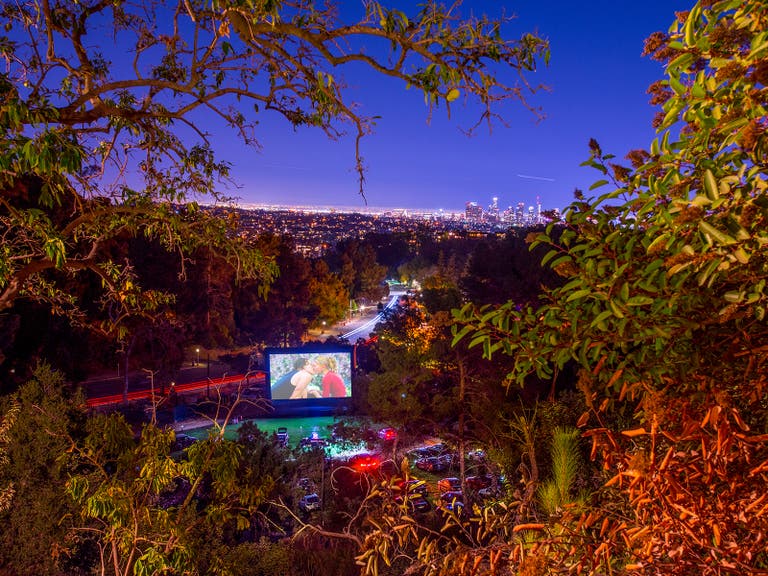Los Angeles Through a Chinese Lens: Part 3

Having already met Susanna Niu (牛承程), Patrick Shi (施沛洋), Maggie Hui (惠江雯), William Chen (陈振麟), and Jenny Xu (徐婧) in Part 1 of our ongoing series about Mainland Chinese students living and studying in L.A., we then heard about their favorite local attractions and destinations in Part 2. Discover Los Angeles now tackles more pertinent and practical topics of life, adjustment, and transportation.
At any given moment, it’s probable that any conversation in or about Los Angeles ultimately turns to driving. The home of Southern California’s renowned car culture, which inspired everything from the surf rock lyrics of the Beach Boys to the iconic images of American Graffiti, L.A. presents a unique landscape to visitors, with its network of freeways and highways that connect the city’s myriad neighborhoods.
Interstate 10, or “the 10” as it’s known to locals, stretches all the way from the San Gabriel Mountains in the east to the shores of Santa Monica State Beach in the west. U.S. Route 101, aka “the 101,” connects Universal City and Hollywood to L.A.’s eastern Los Feliz, Silver Lake, and Echo Park neighborhoods. Interstate 5 (“The 5”) runs north to Burbank, and all roads converge Downtown, where we find our Chinese students, on the campus of the University of Southern California.

“The first time I came here I know I need car if I want to stay here,” comments Susanna Niu, who previously lived in Manhattan as an undergraduate. “It’s really different compared to New York City, [where] you don’t need car … here you need car if you go some places … L.A. is like a region, it’s not like a city.”
Susanna, who lives in Downtown L.A. near USC, quickly learned that native Angelenos prefer to travel on four wheels, navigating the city from the comfort of their own vehicles. But this is not to say that L.A. doesn’t have comprehensive public transportation.

In addition to the LADOT DASH bus system, which connects Downtown L.A. districts from USC and Little Tokyo to Chinatown and Union Station, the Metro Rail system is comprised of six urban subway and light rail lines that run through Hollywood, Culver City, Koreatown and Downtown. Metro also reaches as far away as Redondo Beach and Pasadena, offering visitors and residents reasonable access to many of L.A.’s most famous attractions.

Still, locals love their cars. “The transportation, it’s totally different. We have to have a car and it’s not really … a situation we like,” explains Maggie Hui, who originally hails from Shanghai. “In Shanghai, the public transportation there is really good. You can take the subway to almost everywhere in the city. But here there’s like an adaptation because we need the budget to buy – even if it’s a second-hand car – we still need the extra budget to do it, so there’s a little adaptation from Shanghai to here. But once we have a car we can go everywhere.”

William Chen, much like Maggie and Susanna, also picked up a car after moving to L.A. With William’s previous experience as an undergrad exchange student at UCLA in Westwood, he was well aware of his need for a vehicle upon returning as a graduate student. And while the transition from a public transit commute in his native Guangdong to the car culture of L.A. came as no surprise, William quickly recognized a difference in social attitudes, based strictly on driving habits.
“In China, you switch lanes whenever you see the cars in front of you are driving slow. If you think they are going slow, you switch lanes,” offers William. “Here, people switch less than Chinese people do. They would just follow the previous car and go one-by-one. Even though the line on my lane is longer then the next one, people won’t go, they will just wait. In China they will like change, change.”
Renting an apartment in nearby Koreatown, William - who lives with his girlfriend Jenny Xu, another USC graduate student - mostly uses his car for short trips to school and to his internship at PMK BNC, a PR firm in West Hollywood. Jenny regularly commutes with William to campus, but her job on the FOX lot in Downtown makes the car more of an accessory, rather than a need.

By taking the bus often and occasionally walking, Jenny has found a way to use her commute time to remain connected to her homeland in Taiyuan, something that has become quite easy due to social media.
The rise of social media and numerous free communication channels on the Internet has been of great benefit to all Chinese students living in L.A. And through the use of a Virtual Private Network (VPN), Jenny is able to watch Chinese streaming video sites like YouKu, which help her stay up to date on relevant trends back home, especially during occasional bouts of homesickness.
“I use Weibo in China and I use Facebook here,” comments Jenny. “Now I also use WeChat to keep in touch with my family and friends in China.”
But drawing further on William’s cultural contrasts about driving and traffic, Jenny has also made a few valuable observations about adapting to life in L.A.
“I like the way if you have something in mind, you probably will say it out directly,” adds Jenny. “Everyone here basically obeys the rules of the society. But in China there are many ways to bypass rules. It’s more complex.”
Of course, this is not to say that Jenny and William have figured everything out. Through their educational experience and occasional adventures, the couple has learned a great deal about life, culture, and the city. But still, all social examinations seem to lead back to food, which is a favorite topic of many Chinese students living in L.A.
Perhaps it’s because cuisine is a safe topic, free from any major critiques and criticisms, or simply because food is so intertwined in Chinese culture, but William, Jenny, Susanna, Maggie, and Patrick Shi, another classmate, are all eager to offer opinions on L.A.’s food scene. And while Patrick openly admits to his dislike of Western fare, Susanna is a bit more lenient on her intake, commenting that she “can eat American food only once a day … I’m still Chinese so I need some Chinese thing.”
William and Jenny have come up with their own equation on how to best enjoy food in L.A. The couple mixes their need and preference for Chinese cuisine with an adventurous streak that includes classic American steaks and burgers and Mexican food. And when all else fails, there’s always Korean barbeque, an L.A. staple that dominates the storefronts near their Koreatown flat.
“Usually we eat three kinds of food here. We eat American or Western style food, the second one would be Chinese food, and the third one would be Korean food,” states Jenny. “We’re really close to Koreatown. And my friends in other cities in the U.S. are jealous of us because they think in their place they don’t have many food choices.”

And when trading stories with longtime friends, many of whom have gone on to study in Chicago, Austin, and New York, Jenny has discovered that Los Angeles really is the ideal place for young Chinese to plant their American roots.
Using Chinatown and the San Gabriel Valley as a cultural fail-safe, foreign students never feel too far away from home, aware that there is always the option to feel secure amongst the hieroglyph-laden signs and visual clues of home.
The local Chinese diaspora provides some confidence and familiarity, which makes adapting to local life a bit easier.
“We have the joke, if you couldn’t understand English, like our parents, you can still live in the Chinese community here,” explains Jenny. “You can still survive for several years.”
Jenny’s sentiments are echoed by Susanna, who views L.A. as an ideal launching point for Chinese coming to the US. But while the local Chinese community provides some stability for these foreign students, there is always the possibility, a fear, that many Chinese students in L.A. will simply rely on the comforts of home and limit their exposure to American life, which is a huge part of studying abroad after all.
“We found that the Chinese community here may not be the mainstream society,” comments Jenny, who is set to graduate next week and considering staying in L.A. following commencement. “We still need to survive or find a way to survive or stand out in the mainstream society … so we need to get used to [American] culture and get used to how they speak or how they live their lives.”
Much like the thousands of American expats who have shipped across the Pacific Ocean to take up in China, these international students at USC, hailing from across the Chinese mainland, have found that the key to a successful experience abroad comes from piecing together their native culture with the local, borrowed one. It is this combination of the familiar with the unknown that makes Los Angeles the perfect destination for students like Susanna, Jenny, William, Patrick and Maggie to experience the positive effects of blending cultures and globalization.
But with graduation just around the corner, Maggie also feels the need to share an essential lesson with potential Chinese students coming to L.A.
While she initially considered staying in Los Angeles following the completion of her Master’s Degree in Strategic Public Relations, Maggie has found that, in the eyes of the American government, not all majors are created equal.
“We were trying to find internships and job opportunities, but the visa status, the H-1B, companies don’t sponsor it [for] the major we are in,” adds Maggie. “Language and the understanding of culture may be the foundation of the job or prerequisite. I feel like it’s harder for [Communications students] to find a job here than people who study computer science.”
Maggie’s assertion and observation about the realities of breaking into the U.S. job market come from very real experience. And the H-1B visa of which she was speaking, the temporary work visa for foreign employees, does tend to favor those studying engineering, chemistry, biotechnology, mathematics, architecture, medicine, and health sciences.
But for now, it’s all about graduation, as Maggie, and her classmates William, Jenny, and Patrick prepare to complete their two-year journey at USC.
As for Susanna, she’s approaching the midway point of her Los Angeles adventure, ready to greet one more year on the west coast, and help a new crop of Chinese exchange students navigate through their own immersion into American life and culture.
The stories continue in Los Angeles Through a Chinese Lens: Part 4.

